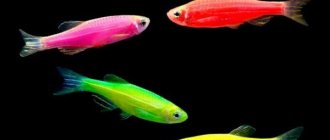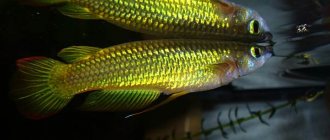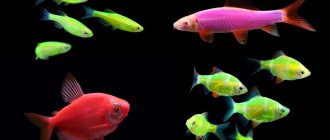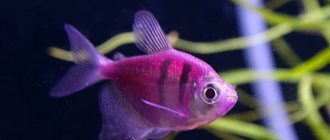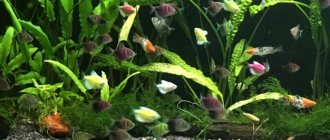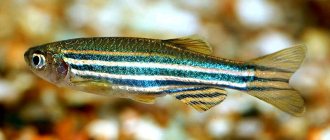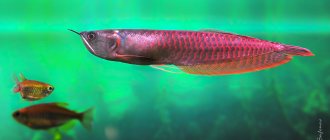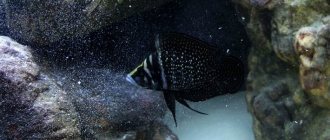If your household members are bored, then throw them an aquarium disco with the help of glofish fish. And chickpeas will not be enough with just one color; the colors of these fish are varied. Just like there are quite a few forms.
Exotic at first glance, GloFish will not bother you at all in caring for them. They do not need to apply daily “makeup”, because although they are colored artificially, the unusual colors of the fish are inherited by them forever. And having learned the noble purpose of their birth, you will become even more interested in them.
Care and maintenance
Danio Glofish are the same unpretentious inhabitants of the aquarium as Danio Rerio, and do not differ from them in the rate of physical development, maintenance and breeding. Glofish have a gregarious lifestyle, move quickly and tend to change direction abruptly. For good health, at least 5-6 individuals should be purchased for the aquarium. Most of the time, the fish are calm and peaceful, but conflicts with nibbling fins and persecution are possible between growing individuals.
- Setting up an aquarium. The bottom should not contain large stones or sharp corners. The soil chosen is dark, homogeneous (for example, gravel, coarse sand, small pebbles). You can cover the bottom with moss or elodea. Lighting – blue fluorescent lamps at the front wall of the aquarium, as well as natural daylight for at least 2-3 hours a day. The center of the aquarium should be free; the edges should be densely planted with myriophyllum, vallisneria, cabomba and other small-leaved plants. Growing Glofish is preferable in aquariums with a closed lid, since the fish may fall out during a jump.
- Optimal chemical composition of water. The water should be fresh, with the optimal amount of microelements: potassium - 30 mg, sodium - 10-20 mg, phosphorus - 1 mg per liter. The environment is neutral or alkaline (pH - 6.5-8). Hardness - reduced or medium (from 50 to 190 units of German hardness).
- Water temperature. Maintain a temperature range from 20 to 28 degrees (closer to the upper limit).
- Aquarium volume. The aquarium must be at least 50 liters (at the rate of 4 liters per individual), the container must be long and rectangular. For a flock of more than 20-30 individuals, an aquarium of 100 liters or more is required, in which it is easier to maintain constant water parameters.
- Filtration, aeration. Aeration should be constant, especially at a temperature of 27-28 degrees. Abundant air saturation is due to the mobility and jumping ability of the flock. To filter water, powerful internal filters are used, which additionally form weak water flows. It is recommended to change a third of the aquarium volume once a week.
Compatibility
Ternetia glofish, just like ordinary ones, prefer to be in a group of their species of 6-7 individuals. In this case, the fish will feel calm and confident and will not display stressful behavior. When stressed, thorns tend to show aggression, biting their neighbors in the aquarium by the fins.
As neighbors, you can choose calm fish of the same size with similar conditions of detention: neons, tetras, zebrafish, barbs, small catfish (ancistrus, corydoras), viviparous fish, gouramis, dwarf apistograms.
Reproduction of Danio Glofish
This may seem strange to some, but breeding fluorescent zebrafish does not seem to be any more difficult than organizing a successful reproductive process in ordinary zebrafish.
It should be noted that sexual dimorphism in zebrafish is almost not developed. Individuals of different sexes can only be distinguished by a more convex abdomen and females. In other external features they are practically no different.
Having chosen one female and several males, it is better to place the fish in different containers for a while. To stimulate spawning in glofish, ideal water temperature parameters should be maintained. It is best to set the temperature at 29-30 degrees. At the same time, we feed the fish with high-quality dry food, mixing in a little fresh brine shrimp.
Glofish are spawning fish, so a temporary shelter should be built first for spawning adults, and then for the growing new generation of luminous fish.
It’s even better to buy a special mesh with small cells, which is installed at a distance of 1 cm from the bottom; this option will be the most reliable.
So, having prepared the spawning tank, we return to the future parents.
First we pay attention to the female. Readiness for spawning is indicated by a seal on the lower part of the body, closer to the anal fin.
If everyone is ready for the process, closer to night we place the individuals selected for spawning in the spawning area and leave them until the morning.
The process of spawning by the female usually occurs early in the morning. The males begin to frantically chase the female, hitting her. From these collisions, the eggs leave the mother’s womb over and over again and slowly sink to the bottom under the protection of a mesh we carefully installed or into the thick of algae.
After this sacrament is completed, the spawned adult fish should be returned back to the general aquarium and kept in optimal conditions for some time.
Within 3-4 days, the eggs ripen, after which tiny larvae emerge from them, which settle on the walls of the tank. At first, such small fry should be fed with ciliates. After a little more time, usually 7-10 days, the fry grow up and swim around the tank on their own.
Now they can be given artemia, and after a month they are practically no different from adult zebrafish in daylight, and from their luminous parents in blue illumination.
Feeding rules
There are no innovations here either. The feeding system for transgenic zebrafish is practically no different from that of other fish of this genus.
You should maintain variety in feeding glofish zebrafish, alternating dry food with brine shrimp in their menu. At the same time, we still focus on purchased flakes; this food should prevail in the daily diet of these fish.
Essentially, we dilute the flakes with live food, not the other way around. In a ratio of 1 to 5. It is better not to give fresh food separately, but to mix it with flakes in the specified proportion. This is a feature of feeding genetically modified fish and should be taken into account.
Also, overfeeding zebrafish should not be allowed, since overeating can lead to disruptions in the fish’s digestive system, and this, in turn, will inevitably lead to health problems. In general, it is reasonable to give the fish a fasting day once a week. This will be enough to remove all toxins and completely reboot the metabolic system of your patients.
Similar colored fish
- Rasbora Trilinear is a peaceful freshwater schooling fish with a forked tail and a black horizontal stripe on the body. Belongs to the Carp family. Unpretentious in diet and maintenance, prefers the upper waters of the aquarium.
- The cardinal is an unpretentious freshwater fish with a peaceful character and a lifespan of up to 5 years. Grows no more than 6 cm. Cardinals live in schools, spawn all year round and can live in aquariums of any size.
- The Cherry Barb is a small and easy-to-care freshwater fish from the Cyprinidae family, well adapted to any water conditions. Suitable for beginner aquarists. It has a rich cherry-gold color. Individuals form small flocks and have a calm and peaceful character.
- Rasbora Harlequin is a hardy, calm fish with a black triangular spot on its sides and golden fins. Harlequins swim in schools, are unpretentious, grow up to 5 cm. They prefer soft water at high temperatures (26-28 degrees) and live food.
Gracilis et al.
In addition to red and blue neon, the following have a natural fluorescent shine:
- tetra flashlight;
- costello or neon green;
- cardinal;
- gracilis or pink neon.
The lanternfly tetra, which came from the Amazon basin, is named so due to the characteristic spots on the body: the golden one adorns the end of the caudal peduncle, and the reddish one is located above the eye.
Neon green (Costello) owes its name to the olive green coloring of the upper half of the body. The lower half has a featureless light silver tint.
The cardinal (alba nubes) is known to aquarists by many names: Chinese danio, magnificent minnow and false neon.
This is interesting! Juvenile (up to 3 months of age) fish display a shiny blue stripe running across their sides on both sides. With the onset of fertility, the strip disappears.
Gracilis, also known as erythrozonus, is distinguished by an elongated translucent body, which is cut through by a bright red luminous longitudinal line . It starts above the eye and ends right at the caudal fin.
Return to content
Features of creating conditions for a comfortable life
Glowing fish are quite small in size, so they do not need large volumes of water. They are equally comfortable in a large aquarium, in a medium-sized tank, and even in a small jar. The main thing is that the fish do not feel crowded in the prepared container. Therefore, when choosing an aquarium, you need to focus on how many individuals will live in it.
The bottom can be sandy or unpaved; fish do not have any particular preferences in this matter. But you need to monitor the water temperature so that the aquarium inhabitants feel comfortable and do not get sick.
In addition, it is worth paying attention to such water parameters as the degree of hardness and acidity. Recommended characteristics of water in the aquarium:
- temperature range – within +28° – +29°C;
- acidity index – from 6 to 7.5;
- hardness – about 10°.
From the editor: Afiosemion southern
Like any other aquarium inhabitant, luminous fish need shelters, the function of which is performed by driftwood and grottoes, and decorations - castles and jugs. There should also be plants in the aquarium. Since the fish do not show any interest in plant aquatic crops, there is no need to be afraid that they will tear them out of the ground with their noses.
Lighting and backlighting
Fluorescent fish will not shine when exposed to regular lamps. To admire the shine and different colors emanating from these fish, illumination must be done using blue and ultraviolet lamps. Aquarists who want to maximize the glow and color of their fish will have to pay a lot of money to purchase special lights designed specifically to illuminate aquariums containing these unusual fish.
Feeding rules
Glowing fish are not picky eaters. However, in order for them to feel comfortable, enjoy the glow and not get sick, the diet should be varied. The menu should include:
- Dry food is a specialized industrial food.
- Products of plant origin, mainly green vegetables - zucchini and cucumbers. It is recommended to give them to the fish periodically so that the pets receive a sufficient amount of vitamins and minerals.
- Live food - coretras, daphnia (but only small ones and bloodworms).
Fish should not be overfed.
It is recommended to remove the remaining food from the water 10 minutes after the start of feeding; this will help keep the tank clean longer. Once every few weeks you can have a fasting day.
Content Features
The maintenance of glofish is not particularly different from the conditions of maintenance of unmodified counterparts, because they have the same diet and lifestyle. For example, zebrafish live for about 4 years, and caring for them is quite simple. They eat standard food - dry and frozen, live and plant-based. Flake food and defrosted brine shrimp in a ratio of 1 to 5 are especially suitable for them.
Without company, zebrafish will quickly wither away, starting by gnawing on their own fins. These small (up to 5 cm) fish will feel good in a school of 6 or more individuals. Although zebrafish have a peaceful and non-combatant temperament, clashes can occur in schools. They can be housed with other species such as lalius, cockerels, barbs, and angelfish. Favorable neighbors also include neons, guppies, swordtails and catfish. You should not introduce cichlids and other fish that can eat their luminous relatives.
There are no strict requirements for the size of the aquarium, but the larger it is, the easier it is to maintain stable conditions in it. The reservoir must be equipped with a lid (it happens that zebrafish jump out of the water), not too deep, but oblong and at least 50 liters in volume. Some water parameters:
The water should be changed no more than once a week. Water replacement is 25% of the total volume.
Special equipment and soil are sold to keep glofish. To highlight the beauty of the glowing fish, the set contains blue lamps and dark gravel, which can also be purchased separately. Glofish will not glow in the light of ordinary lamps.
When well maintained, zebrafish rarely get sick. But they are especially susceptible to velvet disease, mycobacteriosis and intestinal capillariasis.
Fluorescent aquarium favorites
There are many fish that have been genetically modified to glow. But the most famous and widespread are neons and gracilis, which differ from other luminous fish in that their glow is not the result of the work of scientists, but a natural gift.
Neons
Blue neon is unique in that its glow is not the work of biologists and geneticists, but a gift presented by nature itself. Its natural habitat is the Amazon. This species was first discovered and described in 1935 by the French crocodile hunter Auguste Rabot.
The story of the discovery of blue neon is interesting - while hunting crocodiles in the tributaries of the Amazon, Auguste Rabeau caught tropical fever. For many hours the Frenchman lay on the shore, on the verge of death. However, when the body was finally able to defeat the disease, and Auguste woke up, he was tormented by severe thirst, which he was able to quench by scooping up river water. In his palm with water, he came across a small fish shining with blue light.
This is how the resident of the Amazonian tributaries ended up in most aquariums around the world over time. This fish has an unusual, memorable color, which makes it impossible to confuse it with other aquarium inhabitants. A distinctive feature of neon is the presence of a blue stripe on the body, which starts from the eye, reaches the tail and ends smoothly. The color of the abdomen is white, the fins are transparent, the dorsal fin has a white frame with a milky tint.
Neons are unpretentious fish, they are easy to care for, they do not require the creation of difficult conditions for a comfortable existence. But still, certain water parameters will have to be maintained for them.
Neons do not need large tanks. Depending on the number of individuals in the flock and the presence of aquarium neighbors, the required size of the aquarium is selected. The only difficulty an aquarist may encounter is breeding neons. The fact is that their spawning is quite difficult, and during the laying of eggs a couple of fish need to be moved into a separate container with a volume of at least 10 liters.
In 1956, another type of neon was discovered - fish that inhabit shallow reservoirs in South America. In addition to their red color, these neons differ from their blue counterparts in that they grow up to 5 cm, and they have a stripe of bright, rich color running down their body.
Neons' diet should be varied and include live and plant food, industrial dry rations. The character of neons is very simple and flexible. These fish are calm and peaceful; they will not conflict with their relatives or with other aquarium inhabitants.
Other natural fluorescent fish
Neons aren't the only aquarium inhabitants that can glow in a variety of colors. This category also includes:
- Tetra flashlight. This is a fish native to the Amazon River basin. The “flashlight” received its name due to its unusual, original color - at the end of the caudal fin there is a golden spot, another red spot is located on the top of the head, above the eye.
- Costello or green neon. Costello shines with a soft green color with an olive tint. This radiance comes from the upper part of the body, which is colored bright green. But the lower part of the fish’s body is faded and completely unremarkable, painted in a light silver tone.
- The cardinal has other names: “false” neon, magnificent minnow, Chinese zebrafish.
Neon
The first fish whose shine was taken care of solely by nature is considered to be the blue neon, which lives in the tributaries of the Amazon . The discoverer of the fish in 1935 was a Frenchman who hunted crocodiles named Auguste Rabot. In the midst of hunting for crocodiles on the banks of the Ucayali River, he was struck down by tropical fever. For a long time he was on the verge of life and death, and when he woke up, he wanted to drink. They scooped up water for him and in it Rabo noticed a small shining fish.
This is how neon, a native of South America, migrated to the aquariums of city residents. Neon is difficult to confuse with other aquarium fish.
Important! Its trademark is a bright fluorescent blue stripe stretching along the body, from the eye to the tail. The male's stripe is almost straight, the female's is slightly curved in the center.
Both sexes have a white belly and transparent fins. On the dorsum you can see a milky white border.
Sexually mature neons are not capricious and can withstand temperature changes from +17 to +28 degrees, although they will be grateful to the owner for narrower parameters (+18 +23). Problems usually arise when breeding neons, so they carefully prepare for their spawning by acquiring at least a 10-liter glass aquarium.
In 1956, the world learned about the existence of red neon inhabiting the waters of South America. It differs from blue in size, growing up to 5 cm, and in the intensity of the red stripe, covering almost the entire lower half of the body.
Red neons arrived in our country and began to breed in 1961. They are kept in the same way as ordinary neons, but they experience considerable difficulties during breeding. The advantages of both types of neons include their peacefulness and ability to coexist without conflict with other guests of the aquarium.
Return to content
Sales and distribution
Despite the enormous popularity of GloFish among aquarists all over the world, not in every country you can legally purchase such decoration for your aquarium. For example, in the countries of the European Union, the storage and sale of fluorescent fish is prohibited. In Canada, until 2015, fines were issued for the import, possession and distribution of GloFish. This wary attitude of the governments of Canada and the European Union is due to doubts about their safety.
Fortunately, for collectors of aquarium fish, in post-Soviet countries there are no fines or other penalties for storing and distributing GloFish. This means that you can purchase luminous fish for your aquarium in unlimited quantities.
Glofish aquarium - all the colors of the rainbow
There will be live illumination in the aquarium! Such an unusual technology: first shine the light on the fish, so that later, in the dark, it lights up in response!
Wonderful, isn't it?
The phenomenon of fluorescence sounds loud in medicine (carrying out the most important tests), with the help of it our banknotes are provided with an additional degree of protection against counterfeiting, in forensic science it helps to solve crimes where there are traces of blood, but the most unimaginably pleasant use of the glow is to create a unique design in your aquarium . Glofish is a joy for both children and adults. Try to create an aquarium in the GloFish style!
Video about glofish fish
History of creation
GloFish is a patented commercial name for genetically modified aquarium fish. All rights belong to Spectrum Brands, Inc, which purchased them from the creator company Yorktown Technologies in 2021.
And if in our country all this means absolutely nothing and you can easily buy them at any pet store or market, then in the USA everything is much more serious.
The picture is the same in many European countries, where the import of genetically modified organisms is prohibited by law.
True, fish still penetrate into these countries from other countries, and are sometimes sold freely in pet stores.
The name itself consists of two English words - glow (glow, shine) and fish (fish). The history of the appearance of these fish is a little unusual, since scientists initially developed them for completely different tasks.
In 1999, Dr. Zhiyuan Gong and his colleagues at the National University of Singapore worked on the gene for green fluorescent protein, which they extracted from a jellyfish.
The goal of the study was to produce fish that would change color if toxins accumulated in the water.
They introduced this gene into the zebrafish embryo and the resulting fry began to glow with fluorescent light both under ultraviolet and normal light.
After research and obtaining stable results, the university patented its discovery and scientists began further development. They introduced a sea coral gene and orange-yellow fish were born.
Editorial: Guppy
Later, a similar experiment was conducted at National Taiwan University, but the model organism was medaka or rice fish. This fish is also kept in aquariums, but it is much less popular than zebrafish.
Subsequently, the rights to the technology were bought by Yorktown Technologies (headquartered in Austin, Texas) and the new fish received the commercial name - GloFish. At the same time, scientists from Taiwan sold the rights to their invention to the largest aquarium fish breeding company in Asia - Taikong .
Thus, the genetically modified medaka was named TK-1. In 2003, Taiwan became the first country in the world to sell genetically modified pets.
It is reported that one hundred thousand fish were sold in the first month alone. However, genetically modified medaka cannot be called glofish due to the fact that it belongs to a different commercial brand.
However, in the countries of the former USSR it is much less common.
Despite the expectations of the aquarium community (hybrids and new lines very often turn out to be sterile), all glofish are successfully bred in the aquarium and, moreover, pass on their color to their descendants without loss.
The gene donors for the new fish were jellyfish, corals and other marine organisms, including: Aequorea victoria, Renilla reniformis, Discosoma, Entacmaea quadricolor, Montipora efflorescens, Pectinidae, Anemonia sulcata, Lobophyllia hemprichii, Dendronephthya.
Barbus glofish
Scientists have successfully figured out the form: thorns can help you. Next up is size. To do this, the experiment was transferred to the Sumatran barb with the goal of creating the most glofish out of it.
Glofish barbs also look beautiful in the aquarium
Here's what we know about her:
- This is a fairly large fish for an aquarium. Depending on the subspecies, their size can reach up to 35 cm.
- She has a pointed head, a high body, and the tail fin consists of two blades.
- There are always 4 transverse stripes on the body.
Ordinary barbs are so playful that their endless swims only stop when it gets dark in the room. But since after all the genetic manipulations carried out they also glow, then darkness henceforth does not exist for them and there is no peace either. And so on for 6-7 years.
In addition to green glofish barbs, there are also red ones.
The incredible Danio Glofish: the history of the species
Fluorescent zebrafish, or Danio GloFish, is a genetically modified subspecies of the well-known zebrafish. But before describing the features of this unique subspecies, I would like to go back 15 years and remember how it all began.
Work on the creation of transgenic fish began in the late 90s. Moreover, these studies were exclusively scientific and practical in nature. No one then planned to breed aquarium fish that glow in ultraviolet light.
Glofish are the first genetically modified fish!
The interest of scientists was, first of all, to develop genetically modified fish whose color would change when their skin came into contact with certain toxic substances, as well as when these toxins entered the bodies of experimental subjects. That is, the fish were supposed to serve as a kind of detector of pollution in the aquatic environment in which they were located.
Also, and even earlier, at the very beginning of the research, the purpose of breeding luminous fish was the desire of Chinese scientists to trace some purely genetic processes inside the fish cell, that is, the interest was exclusively of a scientific nature and did not concern commerce in any way.
The question of why zebrafish was chosen as an experimental species has its own answer and reasonable explanation.
These fish are generally considered one of the most convenient experimental specimens, since they are extremely unpretentious, can live in small containers, reproduce easily and quickly, and also have an internal anatomical structure that closely resembles the human body.
The creator of the genetically modified zebrafish is a professor at the National University of Singapore, Professor Zhiyuan Gong. It is to him that we owe the appearance of this extraordinary species.
Somewhat later, representatives of the aquarium business drew attention to the appearance of the first luminous samples, offering scientists a contract for the commercialization of this experiment. Thus, GloFish became a patented brand, and the emergence of new varieties of transgenic fluorescent fish for commercial purposes was given way.
Moreover, many countries prohibit the import and breeding of such fish because of their origin. But despite this, they are sold daily and distributed throughout the globe.
Aquarium fish glofish
The biotechnology that makes fish in aquariums glow costs a lot of money. But the beauty business also brings in a lot of income. And in such profitable matters, substitution often occurs.
Unfortunately, this fate did not spare the glo fish either. Scientists from Singapore were the first to receive the result, and only later were colleagues from Taiwan. The Singaporeans worked with zebrafish, and the Thais worked with Japanese medaka fish. Both of them got the desired result, the only difference being that the University of Singapore patented its invention. This patent was bought by the American company Yorktown Technologies, assigning the GloFish trademark to all its glowing fish products.
Medaka fish
Medaka remains just medaka, albeit genetically modified. And it has nothing to do with glofish aquarium fish. Therefore, when buying a fish in the disco style, it would not be amiss to see a certificate confirming that the individual belongs to this official trademark.
Feeding zebrafish glofish
When choosing a suitable food, you need to focus on the small size of glofish zebrafish and their preference to feed at the surface of the water. It is better to exclude inferior live and frozen food from the diet, which can easily become a source of infections in the aquarium.
An excellent choice for feeding zebrafish glofish are the following foods:
- Tetra Micro Crisps are crisps made using a unique low-temperature technology that preserves even more nutrients. The balanced formula combines ingredients of plant and animal origin.
- TetraMin Mini Granules are a complete food in the form of high quality, slow-sinking mini granules with functional ingredients, providing complete daily nutrition for small ornamental fish. Supports healthy growth and vitality of fish, as well as bright colors.
- TetraPRO Energy Multi-Crisps is a food with incredible nutritional properties and an energy concentrate to stimulate vitality. Careful manufacturing technology allows you to maintain high nutritional value and preservation of vitamins, and the prebiotics included in the food improve digestion.
Feeding
Glofish is fed with flakes for tropical fish, to which defrosted brine shrimp or moina, plant seeds, dried worms, bloodworms, daphnia, larvae and crustaceans are added. Fresh food is added to dry food in a ratio of 1 to 5. Tetramine is the most suitable of ready-made food. Fish do not eat food from the bottom of the aquarium (only from the surface and middle part of the water).
Feeding regimen: in the morning, daily, once a day, in small portions. If the fish eat the entire portion in 4-5 minutes, there is enough food.
Examples of food:
- Balanced dry food “Tetramin” 500 ml (600 rub);
- Liquid food with brine shrimp (for fry) “Nobile Fluid Artemia” 50 ml (500 RUR);
- Dry food with carotenoids "Tetra Pro Color" 100 ml (about 200 rubles).
What to do if you overfeed?
When overfeeding, fish are given fasting days, which are repeated once a week. At this time, the diet is limited to granules with plant components (spirulina). Fasting days promote the release of toxins and the prevention of diseases.
Feeding the Sumatran barb
The natural diet of Sumatran barbs is represented by a variety of invertebrates: insects, their larvae, worms, so live or frozen food is often used to feed fish in an aquarium. Unfortunately, they are not balanced and can pose a threat of infecting the aquarium with dangerous parasites, so high-quality dry fish food would be the ideal choice:
1. TetraMin Flakes – universal flake food for all types of ornamental fish. Made from more than 40 types of selected raw materials, it contains all the necessary nutrients and vitamins, as well as probiotics to improve the functioning of the gastrointestinal tract. The high digestibility of the feed reduces the amount of fish waste, which means the water stays clean longer.
2. TetraPro Energy high-energy chips are specially designed for active fish. They are manufactured using gentle low-temperature technology, which allows you to preserve even more nutrients in the feed.
3. Tetra Phyll and TetraPro Algae feeds will enrich the barb’s diet with a very important plant component, which will have a positive effect on health and longevity.
It is necessary to feed barbs several times a day with a portion of food that will be eaten in a few minutes. Don’t forget that fish are prone to overeating, so give them a “fasting day” once a week.
Habitat
The natural habitat of neons is South America. Schools of luminous fish inhabit the basins of the Rio Tacuari, Paraguay and Brasil rivers. They do not like fast currents and are found in slow-flowing tributaries of large rivers, the water of which contains high concentrations of humic substances, giving it a brown tint.
Due to the fact that these rivers flow mainly under the canopy of tropical rainforests, twilight reigns in their depths. A thick layer of silt, regular rains and rotting leaves make the water sour and soft.
Why do fish glow?
The fish were illuminated from the inside by the Pacific jellyfish gene “embedded” in their DNA, which is responsible for the release of green fluorescent protein. The experiment had a strict scientific goal: the experimental subjects became indicators of water pollution, reacting by changing color to foreign toxins.
Editorial: Ancistrus
Biologists shared the results of their successful experiment at a scientific forum, showing a picture of a green transgenic fish, which attracted the attention of a company that sells aquarium fish. Scientists were immediately instructed to breed individuals of a different color, which they did, providing the zebrafish with a sea coral gene, which gave them a red tint.
The yellow glow resulted from the interaction of two genes – jellyfish and coral.
The union of science and commerce was crowned with a contract and the creation of the GloFish brand (from glow - “shining” and fish - “fish”), which became a patented name for transgenic fluorescent fish. Their official manufacturer is Taikong Corporation (Taiwan), which supplies live products under the GloFish brand to America.
And in 2011, the company of shining fish was replenished with purple and blue genetically modified brothers.
Reproduction
Previously, when this aquarium fish first appeared on the market, manufacturers irradiated the offspring so that they would not reproduce. Now it has appeared among our lovers, who can purchase it at the Bird Markets.
The process of reproduction itself is the same as that of the ancestors. External sexual characteristics are practically invisible and the female differs from the male only in her noticeably convex belly. Therefore, the female and 5-6 males are placed in a separate container with a water temperature of 30 degrees and begin intensive feeding with high-quality food. Since the fish spawns eggs, it needs to install algae at the bottom of the spawning tank, where the eggs will fall during spawning. The algae will also hide the eggs from the parents, who may eat their own eggs.
Pet stores sell a special mesh with cells through which the eggs spill to the bottom of the spawning tank, and the parents cannot get it out. The spawning process begins early in the morning and lasts about 2 hours. Afterwards, the parents are placed in a common aquarium and the optimal temperature is maintained in it. The fry begin to hatch after 3 days. At this time, they settle on the walls as small white larvae. In the first week they are fed live dust, and already on the 10th day they are able to eat ground dry food and move freely around the spawning ground. After a month, the fish can be transferred to a community aquarium.
The Danio Glofish is a wonderful little fish that is a marvel of genetics and will fit into any aquarium. In order to see its enchanting color, you need to equip your pond with a special lamp, and the fish will glow in all its glory. Even a novice aquarium fish lover can cope with its cultivation. The main thing is to take care - feed and clean the aquarium on time. And reproduction can be left to the professionals.
Zebrafish breeding
Breeding glofish is prohibited due to licensing restrictions, because luminous fish are considered the intellectual property of Taikong. Zebrafish are relatively easy to breed , for example, unlike cichlids. It is not very easy to distinguish males and females, and it is completely impossible to distinguish fry. As a rule, adult females have a larger and more rounded abdomen.
To prepare zebrafish for reproduction, you need to raise the water temperature to 29-30 C and use high-quality and tasty food. A net is installed at the bottom of the aquarium to protect the eggs from fish. When spawning is over, the adults need to be placed in another aquarium so that the life of the fry is not threatened. You can also use a straw to pump the caviar into another container. The fry will appear in a couple of days. They need to be fed with live ciliates or other microorganisms for up to 8-9 days, then you can switch to brine shrimp.
Description and characteristics
GloFish (GloFish) are genetically modified freshwater fish of the zebrafish species that have green, red and orange colors that glow in the dark. Illuminating the aquarium with ultraviolet lamps makes them shine especially brightly. Their leisurely movement in the water gives the aquarium a particularly decorative look. Changing the DNA of fish had no effect on their behavior, food preferences or life expectancy. Modified zebrafish, in addition to color, are no different from their brothers from natural reservoirs - these are the same peace-loving fish, 3-5 cm long, with drawn horizontal stripes along the body.
Did you know? Fish can drown too. Like a person, it needs oxygen to breathe; if there is not enough oxygen in the water, the fish will suffocate.
Many scientists claim that genetically modified animals, including GloFish, are sterile and cannot reproduce. But this is not entirely true - fish produce offspring, and the neon color is passed on to the children from their parents.
The drug "Antipar" will help cure the fish.
Labeo glofish
Shouldn’t we add a “pepper” character to the aquariums? - the producers thought, and after adding a glow to the shape and size, they decided to introduce this exotic feature to the Labeo fish, making it a full-fledged glofish.
Labeo glofish is a very impressive fish
Their quarrelsome nature is visible to the naked eye, because their tail and body structure are like those of a shark. True, the size is no more than 15 cm. They also differ in their structure by two pairs of mustaches at the mouth and red eyes. You can easily distinguish them throughout the leapfrog of fish by their special style of swimming - belly up or perpendicular to the bottom of the aquarium.
Purple and orange GloFish Labeos have been bred. When introducing these fish into an aquarium, you should take into account the following:
In early childhood, they are able to swim in a school, but as they grow older, their character manifests itself more often, leading the labeo into splendid loneliness.
Labeo glofish purple
They attack either their own fellow tribesmen or brightly colored fish. So if labeo glofish already live in the water, then precedents are possible.
Reproduction has features, which include the introduction of hormonal injections, and the fact that the ability to reproduce will occur only at the age of one year, in a large number of eggs (1.5 thousand), and in the rapid hatching of larvae (10-14 hours).
What makes fish glow?
Aquarium fish that emit light are a product of genetic engineering, the result of the painstaking work of geneticists who implanted the DNA gene from the Pacific jellyfish into the fish. It is responsible for the process of producing a special fluorescent green protein.
What is most surprising is that the experiment on planting the gene was not carried out to obtain fish that would bring beauty and aesthetic pleasure to the aquarium. The goal was to create fish that would respond by changing color to the presence of toxic substances in sea and ocean water, namely, the production of a luminous protein should be activated upon contact with water contaminated with toxins.
The results of the experiment were successful, which scientists hastened to talk about on biological forums, where they posted photographs of fish glowing with bright green light. This information quickly attracted the interest of commercial companies, who saw in these fish a way to make a high profit when selling to aquarists.
Over time, by crossing the genes of corals and jellyfish, the fish were endowed with not only a green glow, but also red and yellow. The results of genetic work on fish were secured by a successful contract between the Union of Science and a commercial organization. This is how a species of luminous fish was developed, called GloFish, which translates as Glo - shining, Fish - fish.
Since 2011, GloFish's species diversity has been expanded with fish that can glow blue and purple.
Popular types
At the moment, the following types of GloFish fish have been bred: zebrafish, ternetsia and barbus.
They are available for purchase in the following colors:
- "Red Starfish";
- "Blue Space";
- "Purple Galaxy";
- "Green Electric";
- "Orange Ray"
Important! Zebrafish species are characterized by curvature of the spine. This disease can manifest itself due to stress or fear. It can be diagnosed by the following symptoms: bulging eyes and gills, scales begin to puff up, and after a while the spine begins to arch. This disease is fatal and has no cure.
Reasons for the glow and brand history
In 1999, while experimenting on fish, Dr. Zhiyuan Gong and his Singaporean colleagues worked with the green fluorescent protein gene of the Pacific jellyfish. Scientists have added a protein gene to the DNA of zebrafish. As a result of the experiment, the fish began to emit a green glow. By adding genes from other sea creatures, scientists obtained their varied colors. So the whole point is not in injections of paints, but only in genetic engineering.
But scientists in Singapore just wanted to observe the internal organs of glofish, since these fish are translucent. The result of the experiment was that scientists photographed green luminous fish, and this photograph caught the eye of a Taiwanese commercial company. The company dubbed the colorful fish “night pearls.”
Glofish is a commercial brand, the name translates from English as “shining fish.” The official manufacturer of transgenic fish is the Taikong company. The first transgenic fish under this brand was produced in 2003 - glofish zebrafish.
Glofish is a commercial brand, the name translates from English as “shining fish.”
Origin story
Glowing aquarium fish were invented and patented in Singapore. Scientists invented them for research purposes - small fish of the zebrafish species were supposed to change their color when toxic substances were detected in water bodies. The first specimens of GloFish were presented at a science exhibition in 2004, where they were noticed by a representative of a company selling aquarium inhabitants. He foresaw the popularity of luminous fish and ordered individual copies for sale.
Familiarize yourself with the rules for caring for such common aquarium fish as: clownfish, veiltail, gura, guppy, barb, parrotfish, mollies, goldfish, swordtail, platie, zebrafish, betta, astronotus, lalius, minora, discus, arowana , surgeonfish, dario dario, angelfish, macropod, macracanthus, cichlids, rhodostomus and labeo.
The great demand for unusual inhabitants of the aquarium led to the invention and patent of the GloFish brand, which became the sole distributor of these fish. Scientists have not stopped their experiments and continue to modify the inhabitants of aquariums - purple and blue zebrafish colors have already gone on sale.
Did you know? Sharks are the only fish with eyelids.
GloFish will look especially advantageous and unusual in an aquarium if the back wall is decorated in dark colors and white sand is poured on the bottom.
How do you get glowing fish?
To obtain a neon glow, scientists had to slightly “correct” the DNA of zebrafish - they added a gene from an anemone, which can glow fluorescent green. The successful outcome of a scientific experiment led to the fact that, at intervals of several years, glowing red and orange fish appeared on the market. The red glow was given to them by the coral gene, and the orange glow was due to the joint introduction of the coral and sea anemone genes. The next step was to change the DNA of another species of freshwater fish - thorns. Experiments on the introduction of jellyfish and coral protein into the DNA of thorns ended successfully and were soon available for purchase.
Important! If you are looking for a company for an aquarium for zebrafish, you will notice that they get along well with catfish, cockerels, guppies, platies, swordtails, shrimp and lalius, but they will not like the proximity to eels, goldfish and carp at all
Ternetia glofish
Since the experiment on introducing the gene responsible for luminescence turned out to be successful, they began to try to introduce this feature into various species of fish. Now the need to populate the aquarium with luminous fish of different breeds has come to the fore. Ternetia is a fish that, thanks to its rounded body shape and beautiful fins, has become the second contender for the title of glofish. This individual can be distinguished by:
- flattened body;
- a beautiful anal fin in the form of a skirt;
- adipose fin in front of the tail along the upper outline of the body.
Ternetia Glofish is one of the most popular neon fish.
Ternetia Glofish behaves in the aquarium like an exemplary excellent student. He is friends with everyone, eats the usual fish food, reproduces willingly, lives up to 7 years. But most importantly, it looks fabulous.
Ternetia glofish has the following colors: orange, pink, red, blue. And in the newest selection, their fins acquired a veil-like type.
